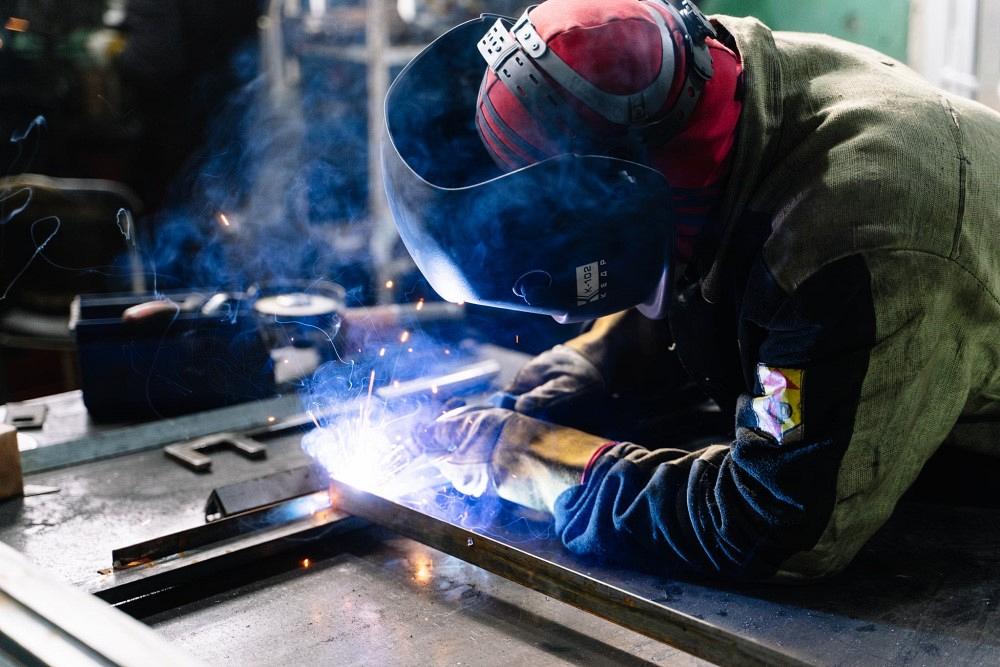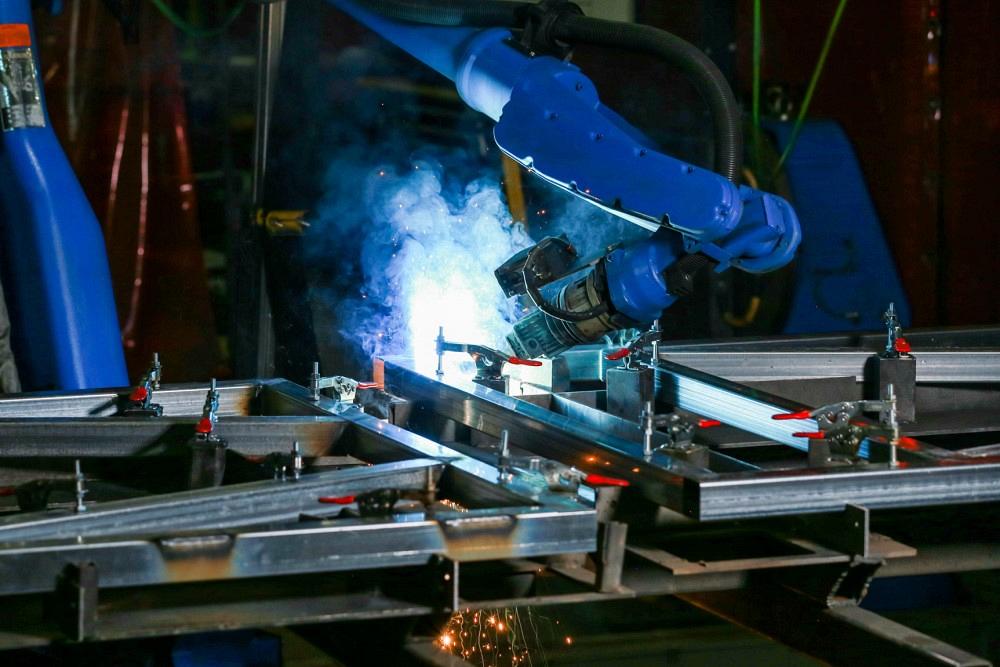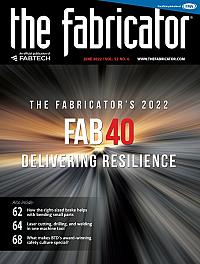Senior Editor
- FMA
- The Fabricator
- FABTECH
- Canadian Metalworking
Categories
- Additive Manufacturing
- Aluminum Welding
- Arc Welding
- Assembly and Joining
- Automation and Robotics
- Bending and Forming
- Consumables
- Cutting and Weld Prep
- Electric Vehicles
- En Español
- Finishing
- Hydroforming
- Laser Cutting
- Laser Welding
- Machining
- Manufacturing Software
- Materials Handling
- Metals/Materials
- Oxyfuel Cutting
- Plasma Cutting
- Power Tools
- Punching and Other Holemaking
- Roll Forming
- Safety
- Sawing
- Shearing
- Shop Management
- Testing and Measuring
- Tube and Pipe Fabrication
- Tube and Pipe Production
- Waterjet Cutting
Industry Directory
Webcasts
Podcasts
FAB 40
Advertise
Subscribe
Account Login
Search
2022 FAB 40: The Metalworking Group navigates unprecedented growth
Cincinnati fabricator nearly doubles its revenue in three years
- By Tim Heston
- June 16, 2022
- Article
- Shop Management
Doug Watts had big plans in 2019. As the new CEO of The Metalworking Group (MWG), No. 37 on the The FABRICATOR’s 2022 FAB 40 list, he saw a company with a solid customer base, some serious potential for growth, but also a few significant inefficiencies. The most obvious one occurred every time he saw a truck arrive or depart the Cincinnati facility, destined for the custom fabricator’s sister plant in Fairfield, Ohio, 10 miles to the north.
“My initial strategy was to continue to grow the business and work to get everything under one roof,” Watts said. “We were shipping parts back and forth, and that led to people having duplicate duties and functions [in both plants]. So we’d benefit from some series efficiencies.”
But then the reality of a white-hot industrial real estate market set in. So did the pandemic and the roller coaster ride that accompanied it, with demand falling and then roaring back, with new customers and opportunities that likely wouldn’t have come to fruition in other circumstances—like hand sanitizer stations and sheet metal components for deep freezers designed to store vaccines. “And we’ve gained customers in the transportation and logistics, and in materials handling,” Watts said. “We’ve grown so much over the past two years, and that’s a credit to our customer base."
Dubay grew up on the sales side, Watts on the accounting side. Watts joined as a cost accountant in 1991, back when the operation was part of Richards Industries, which had purchased the operation years before to support its line of industrial valves and related products. The sheet metal operation was sold in 2000 to Mike Schmitt, the previous company president, who in turn sold MWG to Watts and Dubay in 2019.
“In 2019 I knew that in order for us to be successful, we had to grow the business,” Watts continued. “That way you provide opportunities for people. I started out here in 1991 as a cost accountant. And I bought the business from someone who started out here as a quality manager. There’s so much opportunity here that comes with growth.”
That growth has been unlike anything the company has seen before. In 2019 MWG ended the year with $25 million in sales; in 2022 it’s expecting to bring in more than $43 million—a revenue boost of 70% in just three years.
Inventory Strategy
“This year, inventory has been the No. 1 consumer of our operating cash,” Watts said, adding that inventory’s higher dollar value has come both from increased sales volume and (of course) higher material prices. That’s why this year managers are scrutinizing material purchases, material utilization, and safety stock. It can be tempting to, say, purchase raw material before a potential price hike. That material might have a low price, but carrying that raw stock comes with its own costs. More space for inventory means less space for production.
When Watts observes the plant floor, he isn’t necessarily listening for turrets punching and the lasers cutting. He’s looking for the motion of material as jobs flow through the plant. This year especially, he’s renewed the operational focus on inventory reduction, particularly work-in-process and the safety stock kept in finished goods. “We’re looking at our safety stocks as they relate to order volume,” Watts said, adding that he plans to use data, including sales volume and ordering trends, to optimize stock levels.
The effort also will include “minimizing the jobs that we’re running in excess in demand,” Watts explained, adding that sky-high scrap prices have changed nesting and material utilization strategies. Sales can incorporate sheet yields when determining quantities. But if a customer can’t accept extra parts to fill a sheet (as is more common now) and demands an exact quantity of parts, does the shop nest those extra parts anyway, even if it will produce inventory that won’t be needed any time soon? The cost of storing those parts (especially large parts that consume a lot of space) may outweigh the cost of managing or scrapping the remnant.
Some of the company’s legacy approaches to inventory come from its history of bending over backward for customers. “Part of that effort,” Watts explained, “has been to always have inventory on hand. That’s something our customers really appreciate, but we’re working on a strategy to improve efficiencies for us while also helping the customer.”
This balance includes proactively managing stocking programs for customers, a feat made possible through production capacity from recent technology investments.
Technology Upgrades
When he took the helm in 2019, Watts knew the shop had two older turret punches and three lasers, one of which was an aging CO2 system. He also knew that blanking wasn’t a regular choke point—but painting and finishing was. Considering this, why upgrade blanking when it will just clog a bottleneck downstream?
“Shortly after we purchased the company we brought in a new powder coat line, which gave us capacity to allow the entire shop to run faster,” Watts said. “We removed liquid paint and focused solely on powder coating. That, together with an expanded oven, helped us open a bottleneck and increased our capacity. It really was a double-win.”
With that bottleneck cleared, company leaders turned their focus to cutting, purchasing a 10-kW Mazak fiber laser with a tower and load/unload automation. The system runs 24 hours a day, five days a week, and gives the company enough blanking capacity to ensure downstream operations are never starved for work.
More blanking capacity also put more strain on the forming operations downstream. That led to the company’s latest investment this year, a folder from RAS Systems. Before this investment, brake operators would spend some of their day supporting large blanks, both arms stretched above their heads as they support the blank pivoting upward during the forming cycle for an edge flange. “We can accommodate huge assemblies in our north facility [in Fairfield], but the problem was bending these massive parts on a traditional press brake,” he said. “The folder took a two-person job and made it a one-person job.
“That improvement really shows how we were able to grow the business without adding people,” Watts continued. “We’ve still hired many people, of course, but the correlation between sales growth and hiring isn’t what it used to be.” Between 2019 and 2022, MWG’s headcount increased from about 130 to 180, while overall sales nearly doubled during the same period.
Watts did say that some of the revenue growth has come from material inflation—material costs as a percentage of sales grew significantly, especially in 2021—but the vast majority of revenue growth has come through new opportunities, especially those involving larger fabrications that few area competitors can handle.
The Value of Space
On a recent April morning at MWG’s 110,000-sq.-ft. facility in Fairfield, several welders work on package handling chutes consisting of bump-formed sheet metal. “That space has been able to handle our very large fabrications,” Watts said, “which has been a major market growth sector for us.” (The facility also gives MWG the warehouse space it needs to store and offer stocking programs for these large fabrications.)
The large chute assembly is one among many large fabrications MWG processes, and the fabricator couldn’t do it without its second facility. Carrying work back and forth between the two plants isn’t ideal, but it’s a small price to pay considering the business opportunities the space brings.
Streamlined Quoting
Complicated, large fabrications often involve complicated quoting that can take time. Combine this with the fact that many processes that had previously occurred in the shop, like programming, have now been pushed to the engineering department.

Since 2019 The Metalworking Group has navigated through the pandemic, followed by booming demand. With demand came opportunity.
By mid-June the company plans to roll out a quoting software upgrade using Paperless Parts to standardize and streamline the process while also ensuring quotes are sufficiently detailed. With price trends in recent years, both for material and outside services, the last thing MWG wants is to rely on ballpark quotes. “And we’ve always been very detailed in our quotes,” Watts said. “In fact, having that kind of detail has actually helped us win more jobs.” The trick is having all that data integrated into a system that can produce a detailed quote quickly.
MWG’s goal is to shorten quoting time for complex work from weeks to days. “It’s one thing if you’re quoting an electrical junction box. But as soon as you get into a sheet metal assembly the size of an automobile, with a bunch of components integrated throughout, it can take weeks to get that quote out the door. That’s where we’ll get the biggest bang for our buck with this new software.”
He added that the software will help take engineers out of the weeds of quoting minutiae and allow them to focus more on production strategy. The faster and more effective MWG can quote, the faster it can grow.
Where Are the Assemblers?
New technology purchases have helped make each shop floor employee more productive, but as many fab shop managers can attest, some manufacturing constraints really can’t be addressed without hiring more people. This rings especially true in assembly.
”In April [2021] we received a massive order that needed to be delivered in June,” Watts recalled, adding that the company had the fabrication and finishing capacity to fulfill it. Assembly, though, was lacking. “The people who do assembly just weren’t there,” Watts said. “We could find welders and even machine operators. But people who could work in the assembly and packaging area were just nonexistent.
“Then I thought about my [teenage] son. He had worked for us during the summer of 2020. That was when we were making a thousand hand sanitizer enclosures a day, back when we could still find people [for assembly]. He had never worked a day in his life, and after we opened his first bank account, he came to work here. He got here seven in the morning, wore steel-toed boots, and he did it. Over the period of several weeks, he became vested in the business. He was part of an [assembly] team of four people, and he didn’t want to let them down by missing work.”
By spring 2021 when that large order came in the door, Watts thought about the hours his son put in the summer before. Could the business hire more teenagers? After all, the state of Ohio allows 16- and 17-year-olds to work on a factory floor under certain conditions. They wouldn’t be operating a machine, of course, but they certainly could help in assembly and packaging.
So that’s just what happened. MWG hired a team of teenagers (first tapping some of the executives’ kids’ classmates), cross-trained them on various assembly and packaging tasks, and adapted schedules to accommodate kids’ other activities. Watts added that the shop offered two big draws over retailers and restaurants. First, they didn’t need to work nights and weekends, and second, MWG usually could offer them a larger paycheck.
“They learned to use hand and air tools, they inserted bolts and other hardware. All these parts came off the laser, the press brake, and folder, and these kids assembled the parts, put them on skids, wrapped them up, and got them out the door. They really carried us through the summer.”
Watts understood that most if not all probably wouldn’t pursue a career in manufacturing. But the experience taught them teamwork and at least gave them exposure to the field. After all, most high schoolers are just vaguely aware of manufacturing in general, and they usually have no idea machines like laser cutters and press brakes exist.

CEO Doug Watts (left) joined the organization in 1991 as a cost accountant. Brian Dubay, president, came up through the sales side of the business.
A Virtuous Cycle
Look up at the ceiling of MWG’s original facility in Cincinnati, and you can see telltale signs of additions constructed over the years. “We have addition after addition after addition,” Watts said, “and it’s all completely filled with equipment. The workflow isn’t optimal, but it works for us.”
He added that bringing everything under one roof, in an open facility, would give MWG a blank canvas to start fresh and build an ideal workflow, from the office through cutting, bending, manual and robotic welding, powder coating, assembly, and shipping. But work still moves in the current layout. Batch sizes are manageable, and WIP and finished goods are still being scrutinized and reduced if necessary. “I’ll continue to passively look for a new building,” Watts said, “if only to be ready to jump when the right opportunity presents itself.”
Starting his metal fabrication career in the early 1990s, Watts had thought he saw everything: the rise of globalization, the dot-com bust, the Great Recession. Then came the pandemic and yet another unexpected roller coaster. No one knows what might come next. But MWG continues to make incremental improvements, reinvest in technology, grow its customer base, present more opportunities for employees, who in turn present more ideas for improvement—and the virtuous cycle continues.
About the Author

Tim Heston
2135 Point Blvd
Elgin, IL 60123
815-381-1314
Tim Heston, The Fabricator's senior editor, has covered the metal fabrication industry since 1998, starting his career at the American Welding Society's Welding Journal. Since then he has covered the full range of metal fabrication processes, from stamping, bending, and cutting to grinding and polishing. He joined The Fabricator's staff in October 2007.
subscribe now

The Fabricator is North America's leading magazine for the metal forming and fabricating industry. The magazine delivers the news, technical articles, and case histories that enable fabricators to do their jobs more efficiently. The Fabricator has served the industry since 1970.
start your free subscription- Stay connected from anywhere

Easily access valuable industry resources now with full access to the digital edition of The Fabricator.

Easily access valuable industry resources now with full access to the digital edition of The Welder.

Easily access valuable industry resources now with full access to the digital edition of The Tube and Pipe Journal.
- Podcasting
- Podcast:
- The Fabricator Podcast
- Published:
- 04/30/2024
- Running Time:
- 53:00
Seth Feldman of Iowa-based Wertzbaugher Services joins The Fabricator Podcast to offer his take as a Gen Zer...
- Industry Events
Pipe and Tube Conference
- May 21 - 22, 2024
- Omaha, NE
World-Class Roll Forming Workshop
- June 5 - 6, 2024
- Louisville, KY
Advanced Laser Application Workshop
- June 25 - 27, 2024
- Novi, MI
Precision Press Brake Certificate Course
- July 31 - August 1, 2024
- Elgin,

































